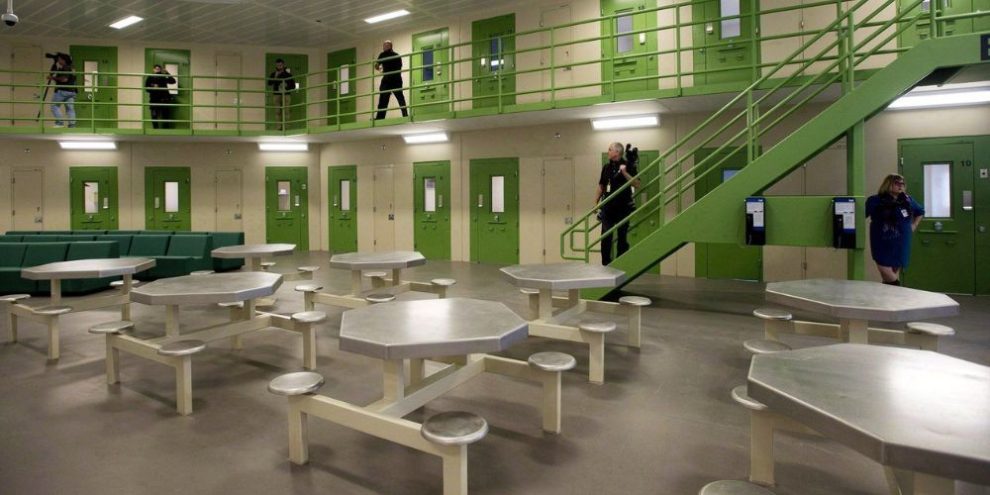
By Liam Casey
Ontario's jails have seen a dramatic increase in the number of inmates over the past year with the majority of the facilities well over capacity, new data obtained by The Canadian Press shows.
Meanwhile, an overwhelming number of inmates held – 81 per cent, the government said – are awaiting trial and presumptively innocent.
The data, obtained through freedom-of-information laws, shows the average inmate count and institutional capacity over the past 10 years for the province's jails. Those institutions hold people accused of a crime but not out on bail, as well as those serving sentences of two years less a day.
As of Sept. 30, 2023, there was an average of 8,889 people in provincial jails, well over the 7,848-person capacity. Overall, the jails were operating at 113 per cent capacity at that time.
Most of Ontario's institutions were over capacity in 2023, the data shows.
Maplehurst Correction Complex in Milton, Ont., was the most overcrowded last year, with an average inmate population of 1,188 but official capacity for 887 – meaning it was operating at 134 per cent capacity in 2023.
Elgin-Middlesex Detention Centre in London, Ont., was a close second at 133 per cent capacity, with an average 471 inmates while having operational capacity for 353.
South West Detention Centre in Windsor, Ont., was operating at 129 per cent capacity, with 337 inmates but space for only 262 people.
Criminal lawyers and corrections officers say the overcrowding in jails has led to several problems, including cramped living conditions for inmates and an increase in assaults on correctional officers.
Inmates are triple bunking in single cells in several institutions, said Chad Oldfield, a corrections spokesman for the Ontario Public Service Employees Union.
Correctional officers are increasingly assaulted, he said, and operational stress injuries and post-traumatic stress for the guards is on the rise.
"We've also lost a number of staff who have died by suicide over the last year," he said. "You've got climbing inmate counts and then you've got staffing shortages, it's just a recipe for disaster."
Correctional officers are third among occupations with approved work-related stress injury claims registered with the Workplace Safety and Insurance Board between 2016 and 2022, WSIB data shows. Only police officers and paramedics have more stress injury claims.
Solicitor General Michael Kerzner, who is responsible for Ontario's jail system, did not answer repeated questions about jail population numbers or the province's plans to deal with overcrowded institutions.
Instead, he spoke about hiring 1,000 more correctional officers and touring jails.
"Public safety is a priority, will always be a priority and we have a right to live safely in our communities," Kerzner said.
Oldfield, of OPSEU, said those 1,000 jobs are contract workers.
The province is building a new 345-bed jail in Thunder Bay, Ont., that will replace the current jail and double its capacity. The government also plans to build a 235-bed jail in eastern Ontario but that project has met opposition from locals, who don't want to see it built on prime farmland.
Last week, the Canadian Civil Liberties Association released a report that said the country's bail system had worsened significantly over the past decade. It said the proportion of inmates in jail awaiting trial had reached a record 79 per cent by 2022.
The Criminal Lawyers Association argued the rise in inmates is due to Crown attorneys opposing more bail, specifically for alleged gun crimes and other serious, violent offences.
That means inmates stay behind bars as defence and prosecution prepare for bail hearings, thereby increasing the jail populations, said Boris Bytensky, president of the lawyers' association.
"The positions that Crowns are taking on bail matters are becoming more and more conservative," Bytensky said.
The office for Ontario's Attorney General did not respond to questions about whether the government gave direction to Crown attorneys to oppose more bail applications.
Doug Downey's spokesperson said the province is investing $112 million over three years to "ensure that high-risk and repeat violent offenders comply with their bail conditions, and prosecutors have the resources to conduct bail hearings."
"Keeping violent, repeat offenders who commit crime while out on bail behind bars will keep our province safer," said Andrew Kennedy.
During the COVID-19 pandemic, there was a concerted effort to reduce jail numbers when it became clear by April 2020 that the novel coronavirus spread rapidly in congregate settings.
The average number of inmates dropped to 6,661 in 2020, from an average of 8,049 in 2019, the data shows.
Bytensky, of the Criminal Lawyers Association, said there wasn't a subsequent jump in crime rates. In fact, he said, there was a significant drop in crime during the pandemic with a few exceptions like a surge in domestic violence charges.
Premier Doug Ford has long pushed a tough-on-crime agenda, but his comments about being tougher on bail ratcheted up after an Ontario Provincial Police officer, Const. Grzegorz Pierzchala, was shot to death in late 2022. The accused shooter was out on bail at the time and had a lifetime weapons ban.
Ottawa in late December passed new federal laws that see repeat violent offenders who use weapons prove to court they are not a safety or flight risk, a reversal from the onus on the prosecution to prove that.
Ford's rhetoric hit a fever pitch in recent days when he said his government wanted "like-minded judges" to be tougher on accused criminals. His comments, which he "quadrupled down" on over a series of days at Queen's Park, sparked furor in the legal profession and from the opposition.
Bytensky said long waits for bail hearings have cost people jobs, housing and, in some cases, custody of children.
Meanwhile, since the vast majority of inmates have yet to have their day in court, there's no programming for them, he said.
"They're not receiving any rehabilitative steps that will help them reintegrate back into the community," he said. "In fact, it's quite the opposite."





